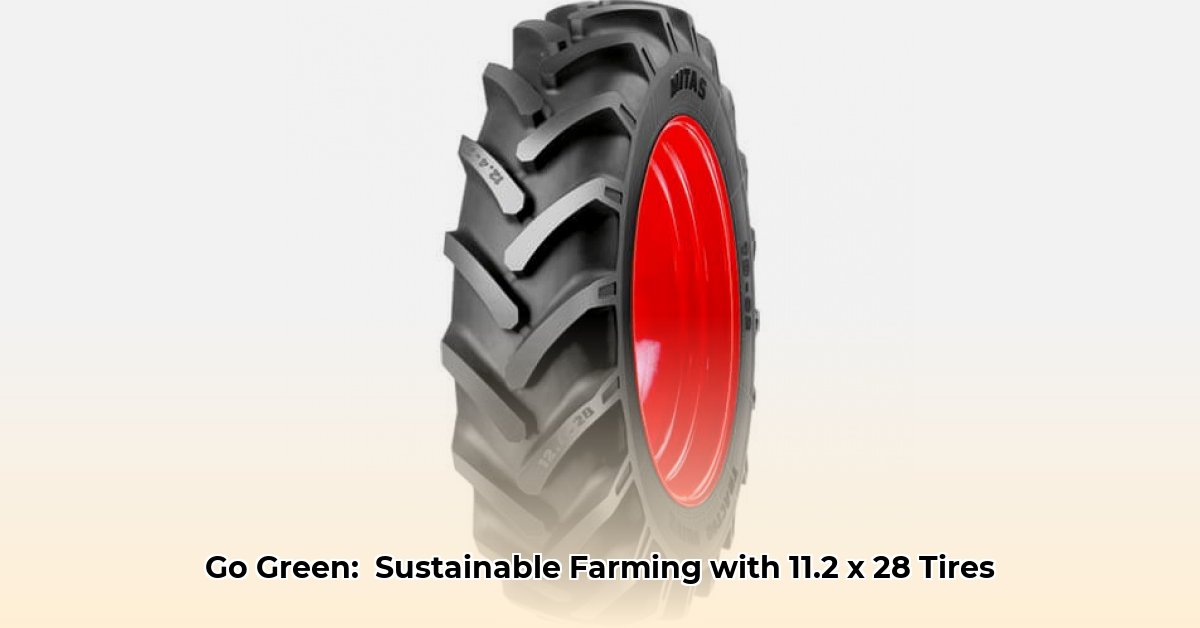
Understanding the 11.2 x 28 Tractor Tire: Balancing Performance and Sustainability
Sustainable agriculture demands efficiency in every aspect, and tire choice plays a surprisingly significant role. The 11.2 x 28 tractor tire, a common size for many agricultural operations, offers a compelling case study in balancing performance with environmental responsibility. This article explores the features, benefits, and economic considerations associated with 11.2 x 28 tires, providing actionable insights for farmers seeking to enhance both their bottom line and their environmental footprint. We'll also examine the practical steps needed to maximize tire lifespan and fuel efficiency. For information on other sizes, check out these other tractor tire sizes.
Tire Specifications and Performance: A Comparative Analysis
The 11.2 x 28 tire size isn't monolithic. Performance varies significantly based on factors such as tire construction (radial vs. bias-ply), rubber compound, and manufacturer. Key performance metrics to consider include load capacity, rolling resistance, and traction.
A hypothetical comparison showcasing these variations follows:
| Feature | 11.2 x 28 Tractor Tire (Example A) | 11.2 x 28 Tractor Tire (Example B) | Standard 11.2 x 28 (Example C) |
|---|---|---|---|
| Load Capacity (lbs) | 4,500 | 4,200 | 4,000 |
| Rolling Resistance | Low | Medium | High |
| Traction | Excellent | Good | Fair |
| Approximate Price ($) | $400 | $350 | $300 |
| Estimated Lifespan (Hours) | 2000 | 1500 | 1000 |
Note: This table presents hypothetical data for illustrative purposes only. Actual specifications will vary significantly depending on the manufacturer and tire construction.
This variation highlights the importance of carefully examining manufacturer specifications before purchasing. Lower rolling resistance, for instance, directly impacts fuel efficiency and operational costs, while optimal traction is essential for various farming tasks.
Impact on Fuel Efficiency and Greenhouse Gas Emissions
Lower rolling resistance translates directly to lower fuel consumption. Studies have shown that tires with reduced rolling resistance can significantly decrease fuel usage by up to 15% compared to standard tires. This reduction in fuel consumption directly correlates to a decrease in greenhouse gas emissions, contributing to a smaller carbon footprint. Don't underestimate this impact on your farm's overall environmental performance.
Economic Considerations: A Total Cost of Ownership Analysis
While premium low-rolling-resistance 11.2 x 28 tires often have a higher initial purchase price, a total cost of ownership (TCO) analysis reveals the long-term savings. The reduced fuel consumption, combined with a potentially extended lifespan due to reduced wear and tear, can result in substantial cost savings over the tire's lifetime. A straightforward calculation comparing fuel costs over the lifespan of different tires will help determine the economic viability of investing in higher-priced low-rolling-resistance options.
Practical Recommendations for Farmers: Maximizing Tire Performance and Lifespan
Maintain Proper Inflation: Consistent tire pressure is crucial. Underinflation significantly increases rolling resistance, while overinflation can cause damage and reduce traction. Always refer to the tire's sidewall for the recommended pressure. Consider a Central Tire Inflation System (CTIS) for ease and accuracy.
Regular Inspections: Regularly inspect tires for wear, cuts, bulges, or embedded objects. Early detection allows for timely repairs, preventing premature replacements and reducing costs.
Tire Rotation: Rotating tires according to the manufacturer's recommendations ensures even wear distribution, extending their lifespan.
Proper Storage: During periods of inactivity, store tires in a cool, dry environment, away from direct sunlight and extreme temperatures, to prevent damage.
Future Trends and Research: Innovations in Sustainable Tire Technology
Ongoing research into sustainable materials and improved designs promises even greater fuel savings and longer-lasting tires in the future. Watch for innovations in rubber compounds and tire constructions that further enhance both efficiency and environmental sustainability.
Conclusion: Striking a Balance Between Profitability and Environmental Stewardship
Choosing the right tractor tire is a decision with far-reaching consequences. The 11.2 x 28 tire, when selected with an eye towards low rolling resistance and proper maintenance, can enhance both a farm's economic performance and its environmental sustainability. By carefully considering the factors discussed in this article, farmers can make informed choices that foster both profitability and responsible stewardship of the land.